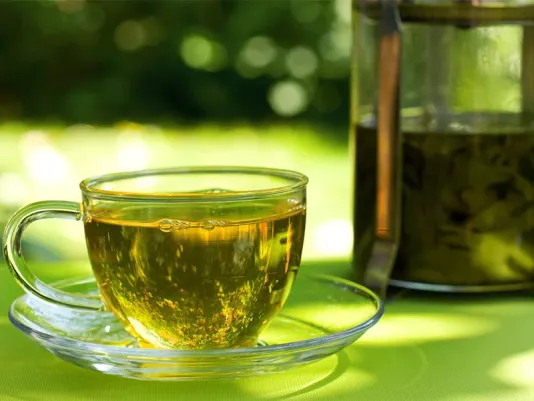Dill Cocktail
Dill Cocktail – swedish cuisine recipe, fragrant and beautiful cocktail.

Green Tea is more than just a drink. Over years of preparation, I’ve realized its influence on dishes and beverages runs deeper than it seems. It gives marinades a gentle aroma, adds clarity to desserts, and even brings balance to sauces. The key is understanding how the leaves behave under different temperatures and taking your time. Working with tea requires consistency – from selection to serving. I always say that green tea loves purity – pure water, clean utensils, and a calm atmosphere during brewing. It’s not a ritual for show but a way to show respect for the ingredient. Good tea doesn’t tolerate haste but generously rewards patience with clarity of flavor, soft aroma, and a lightness that’s unmistakable.
Over years of working with different varieties, I’ve learned to recognize quality green tea by its appearance and aroma. Good tea has dense, even leaves with a matte sheen and a clean, grassy scent free of smoke or mustiness. If you notice sharp bitterness or dustiness, it’s a sign of an old or poorly stored product. I always pay attention to the edges of the leaves – they should be whole, not broken. Green tea is sensitive to moisture and odors, so I store it in an airtight jar, away from spices and coffee. From practice, I’ve noticed that even the best tea loses its aroma if left in open packaging. For daily use, it’s better to buy small portions rather than stock up for a year. Freshness is the foundation of its flavor. I also check the origin – region, processing method, and packing date. The variety isn’t always decisive; what matters is that the leaves are properly dried and not over-roasted. Then the brew turns out clear, soft, with delicate astringency and no bitter aftertaste.
I always tell my students: the success of green tea begins before the water touches the leaves. Before brewing, the leaves should be “awakened” – briefly rinsed with warm water to remove dust and activate aromatic compounds. This gives the drink purity and depth. The water should be soft, low in minerals, since hard water alters the flavor. Filtered or spring water works best. I never bring water to a boil – that’s the first mistake beginners make. Overly hot water scorches the leaves, making the tea bitter. The ideal temperature is around 75-80°C (167-176°F). The amount of leaves also matters: about one teaspoon per 200 ml of water. Too many leaves make the tea strong but take away its finesse. I usually steep it for 1-2 minutes, watching the leaves slowly unfurl. After that, it must be strained immediately – leaving it in water continues extraction and spoils the taste.
Temperature defines the character of green tea just as heat defines the texture of meat. In my experience, even a 5°C difference can shift the aroma balance. When the temperature is too high, tea loses its floral notes and gains coarse bitterness. If the water is too cool, the drink turns weak and watery. When preparing cold brews, I always steep tea in the refrigerator for 6-8 hours using cold water – this gives a soft, clean flavor without astringency. For warm brews, it’s important to ensure the teaware isn’t overheated – ceramic or glass teapots retain heat evenly without letting the water boil. I never place the pot directly over an open flame, even when I’m in a hurry. Thin leaves burn easily, and the aroma loses depth. Depending on the variety, the same leaves can be infused several times, but each time the temperature should be slightly higher – that’s the natural way to release the layers of flavor. Anything beyond temperature control leads to losing the essence of green tea.
Green tea has a unique ability to support flavor without overpowering it. Over the years, I’ve learned to add it to fish sauces, cold marinades, and even baked goods. For example, tea infusions beautifully reveal the taste of citrus and spices. In desserts, it pairs wonderfully with white chocolate or yogurt creams. It’s important not to overheat the liquid when adding tea to sauces – the warmth should be barely perceptible, or the aroma will fade. For meats, I use tea as a glaze base – it adds shine and a hint of bitterness. With dairy, caution is needed – overly strong tea can create a metallic taste. In my practice, I always test proportions in small batches to avoid spoiling the dish. Perfect harmony is achieved when green tea serves as a background, not the dominant note. It works as a natural flavor enhancer, adding a sense of purity and lightness.
Most problems with green tea arise from haste or neglecting details. I often see people using boiling water, leaving the leaves steeping too long, or using poor-quality teaware. All this ruins the taste. The most common mistake is over-steeping: the tea becomes bitter, and no lemon can fix it. Another is storing it near spices or coffee – the leaves instantly absorb foreign aromas. I always check the scent before brewing – if it’s changed, it’s better not to risk it. Another key factor is water purity – even slight sediment or a chlorinated taste can distort the aroma. Quality control begins with mindfulness. I often brew a test portion to assess the flavor and color of the infusion. If the drink is cloudy or smells harsh, something went wrong – either the temperature or the leaves. Good green tea is always clear, with a soft herbal tint and a clean aroma. There’s no magic in this – only precision and experience that come with practice.